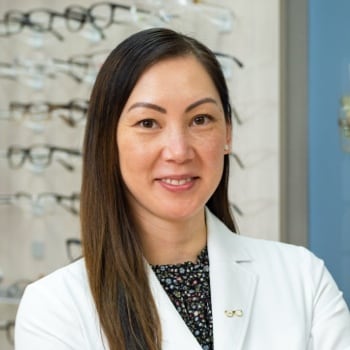Droopy eyelids, also called ptosis, can be a natural part of aging, but they’re not something you have to live with. For some, sagging lids are a minor cosmetic concern. For others, they can get in the way of everyday vision and confidence.
Depending on what’s behind the sagging, treatment might include non-surgical options like prescription eye drops, skin-tightening treatments such as Plasmage, OptiLift, or corrective eyelid surgery.
Knowing what might cause drooping eyelids and understanding your options for treatment, can help you feel more in control of your eye health and appearance.
What Causes Droopy Eyelids?
Age-Related Changes
As we age, the muscles responsible for lifting the eyelid can weaken, and the skin can lose elasticity. This causes the upper eyelid to gradually sag or droop, often on both sides.
Genetics
If droopy eyelids run in your family, you may be more likely to experience them. This type of inherited ptosis, known as congenital ptosis, can appear earlier in life and may become more noticeable over time.
Medical Conditions
In some cases, droopy eyelids may be linked to underlying medical conditions, such as:
- Neuromuscular disorders like myasthenia gravis
- Nervous system conditions like Horner’s syndrome
- Injury or trauma affecting the eye or surrounding tissue
If your ptosis appears suddenly or is accompanied by other vision changes, it’s important to have it evaluated by an eye doctor.
Can You Prevent Droopy Eyelids?

While you can’t always prevent ptosis, especially when it’s tied to aging or genetics, there are a few ways to care for your skin and protect your eye area over time:
- Protect yourself from sun damage: Wear UV-protective sunglasses and apply sunscreen around the eyes.
- Keep up with regular eye exams: Routine visits with your optometrist can help detect underlying issues like nerve or muscle problems, before symptoms become more serious.
- Be gentle with makeup removal: Tugging or scrubbing the skin can stretch it over time.
- Hydrate & sleep well: Good hydration and quality sleep help keep skin firm and reduce puffiness.
- Avoid smoking: Smoking accelerates skin aging and weakens collagen structures.
- Invest in skincare: Products with peptides, hyaluronic acid, and retinol may support skin firmness.
Can You Treat Droopy Eyelids Without Surgery?
Yes, non-surgical options exist and can work well for certain cases. Your treatment plan will depend on how severe your ptosis is, what’s causing it, and your personal preferences.
Eye Drops for Temporary Lift
Prescription eye drops like oxymetazoline can temporarily stimulate the muscle that raises the eyelid. While the effects are temporary, they can offer a noticeable lift throughout the day, making them a helpful option for managing ptosis in milder cases.
Eyelid Exercises
Eyelid exercises can be a gentle way to engage the muscles around the eyes and may offer subtle improvements over time. While they won’t replace medical treatments, simple practices can help reduce muscle fatigue and support eyelid function. Here are a couple to try:
- Blinking reps: Blink quickly for 30 seconds, rest, then repeat a few times.
- Light resistance: Gently place a clean finger on your upper eyelid and try to close your eye against the pressure.
These small movements can help maintain function in mild cases of ptosis or after treatment to support long-term results.
How Plasmage Treats Droopy Eyelids
Plasmage is a noninvasive treatment that uses plasma energy to tighten the skin around the eyes and reduce drooping. It’s often chosen by people looking for a non-surgical solution to address mild to moderate eyelid sagging.
The treatment works by creating tiny, controlled micro-injuries in the upper layer of skin. This process triggers your body’s natural healing response, encouraging new collagen production and tightening the skin over time.
Benefits of Plasmage for eyelid concerns include:
- No incisions or stitches required
- Minimal downtime and recovery
- Gradual, natural-looking improvements in skin texture and firmness
- Targets fine lines, wrinkles, and sagging in delicate areas like the upper eyelids
While results can vary, many people notice smoother, firmer skin in the treated area after just one session. For those looking to refresh their appearance without surgery, Plasmage offers a practical, low-risk option.
How OptiLift Treats Droopy Eyelids
OptiLift is an innovative, non-surgical option for addressing droopy eyelids and improving eyelid function. Unlike Plasmage, which focuses on tightening the skin, OptiLift uses Dynamic Muscle Stimulation to target the Orbicularis Oculi muscle behind the eyelids. By stimulating this muscle, OptiLift provides a workout that helps strengthen and tighten the eyelids.
This process not only enhances the aesthetic appearance—making the eyelids look firmer and less tired—but also offers functional benefits. Strengthening the eyelids improves the seal when blinking, addressing a significant cause of Dry Eye.
Benefits of OptiLift include:
- Comfortable treatment with no needles or scalpels
- Quick sessions that fit easily into your schedule
- Natural-looking results that improve gradually over time
- Can be combined with other therapies like Plasmage or skincare for enhanced outcomes
- Functional improvement in eyelid seal, reducing Dry Eye symptoms
OptiLift is ideal for those seeking tighter, refreshed eyelids with both cosmetic and functional benefits, all without the downtime associated with surgery.
Surgical Options
In cases where ptosis affects vision or when non-surgical methods don’t offer the results you want, surgery may be the best option.
Blepharoplasty
Blepharoplasty is a procedure that removes excess skin, fat, and tissue from the upper eyelid. It’s often done for cosmetic reasons but can also improve field of vision if sagging lids obstruct sight.
Ptosis Repair
This surgical option focuses on strengthening or shortening the muscle responsible for lifting the eyelid. It’s typically used when the muscle has weakened significantly and isn’t functioning well on its own.
Let’s Talk About Your Eyelids
Droopy eyelids aren’t something you just have to accept, whether they’re affecting how you see, how you feel, or both. There are safe, effective ways to address them.At Eyes on Plainville, we offer noninvasive solutions like Plasmage, as well as thorough exams to help determine what’s right for your eyes. Book your appointment today to explore treatment options and learn how we can help you lift and refresh your look with no surgery required.





